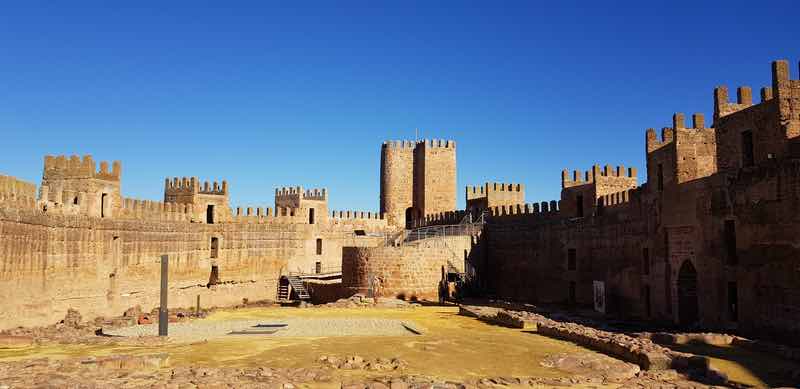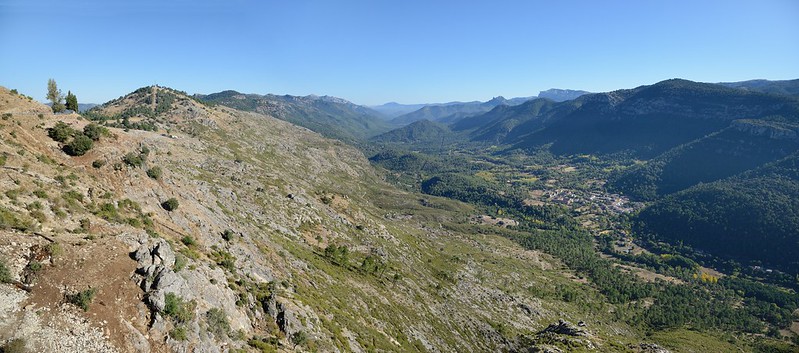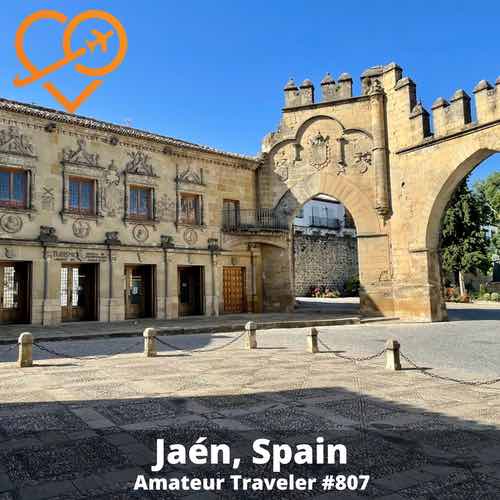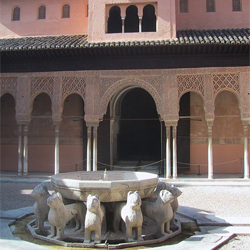
View from the Castle of Santa Catalina (Jaén)
The state of Andalucia in southern Spain takes up a large portion of Spain. Andalucia is about the size of the country of Austria or the U.S. State of Maine. It is a well-known tourist region for cities like Sevilla, Malaga, Marbella, Grenada, and Cordoba. But, because it is so large, some of its 8 provinces are well off the tourist route and one such province is Jaén.
Jaén was not on my radar at all until I attended a travel blogging conference, TBEX, in Marbella. When I was looking at post-conference press trips, I was intrigued by one to the UNESCO sites of Úbeda and Baeza. I had never even heard of these two cities, but let me try and convince you that they belong on your itinerary to Spain.
Table of contents: ()

View of the city of Jaén from Castle of Santa Catalina
Province of Jaén
Olive Trees
If there is one plant that influences the landscape of Jaén it is the Olive Tree. The number of olive trees in the region is around 65 million. It produces 43% of Spain’s olives and 28% of the world’s supply of olives. Jaén produces more olives than the entire country of Italy.
While olive trees have grown in the region since the time of the Romans, the area used to also have large vineyards before Europe’s vineyards were all but wiped out by the phylloxera pestilence in the late 1800s. Since 1888, the number of olive groves has tripled in the area.
What is left is a beautiful green patchwork of olive trees connecting the valleys between hilltop cities. For scenic beauty, I think the area rivals Tuscany. Of course, it is also great if you want some really good olive oil with your dinner.

Burgalimar Castle photo by Molly Sears-Piccavey
Battles and Castles
The other force that shaped the region was war. In 1246, the Catholic armies of the Kingdom of Castile recaptured the capital city of Jaén (also called Jaén) from the Moors. Until the fall of Grenada to the reconquest in 1492, Jaén was the border between Catholic Spain to the north and Muslim Spain to the south. The Spanish call this region the land of battles and castles.
There were 400 or so castles and watchtowers built in the province with 90 of them still standing in some form. Andalucia tourism boasts that Jaén has “the highest concentration of castles and watchtowers in the whole of Europe”. These include the Castle of Burgalimar in Baños de la Encina which is the oldest preserved castle in Spain.
National Parks
If you love the outdoors, the province of Jaén has 4 natural parks: Despeñaperros Natural Park, Sierra de Andújar, Sierra Mágina, and Sierras de Cazorla, Segura y Las Villas Natural Park. One-fifth of the area of the province is Sierras de Cazorla, Segura y Las Villas Natural Park which is the largest protected area in Spain and the second largest in Europe. It is a UNESCO-declared biosphere reserve.
The 4 parks include river gorges, waterfalls, Neolithic caves, wolves, lakes, and snow-capped mountains.
When To Visit Andalucia
If you are visiting the beaches of Andalucia along the Costa del Sol or the Costa de la Luz, then summer can be a peak season, but when you visit the interior cities and regions like Jaén, Sevilla, Cordoba, or Grenada the summer temperatures soar. During my visit in June, the temperatures in Sevilla were 104 °F at 3 pm so I did what the locals do and took a siesta. Two hours later at 5 pm the temperatures had gone up to 107 °F.
In the narrow streets of the old town, the temperatures can feel 10 °F cooler or in the hilltop towns of Baeza or Úbeda you can get a cooling breeze. Hotel prices are much lower in the summer, and in June near the longest day of the year, the sun won’t even go down until after 10 pm. Late spring or early autumn are a more comfortable time for visiting.
Historic Jaén
The press trip I went on was sponsored by (paid for by) the Andalucia Tourism board. They focused on the history and architecture of three important cities in Jaén: Jaén, Úbeda, and Baeza. As I mentioned above, the last two are a UNESCO world heritage site.
City of Jaén
Castle of Santa Catalina
We started our tour of the city of Jaén on the hill overlooking the city. This is the site of the historic Castle of Santa Catalina. This castle had a commanding view of the countryside, including the hills to the south where Grenada and the Moors were.
You can tour the castle grounds with its five towers and central donjon for a small entrance fee.
Even if castles are not your thing, you can visit the cross that recalls one placed there by conqueror Ferdinand III. There are great views of the city from there including of the city’s main cathedral. Visiting the cross is free.
Parador de Jaén
We stopped for an amazing tasting lunch in the Parador de Jaén which was built right next to the castle with the same commanding view. While the castle was built after the reconquest in the 1200s, the Parador was built in 1965 under Franco to look as if it were built in the 1200s.
If you are not familiar with Paradors, they are a system of hotels owned and run by the country of Spain in significant historic buildings or, as in this case, in significant locations. They are a treasure and I highly recommend a stay or at least a stop at the various Paradors in Spain.
Cathedral of Jaén
If you have never been to Jaén but still feel that the impressive cathedral of Jaén looks familiar, it might be because this church inspired the design of churches in the new world including Mérida, Guadalajara, Puebla, Lima, and Cusco. Because of that significance, the cathedral has been proposed as a UNESCO world heritage site.
The design of the cathedral by architect Andrés de Vandelvira was influenced by one of the significant relics that the church holds. It purportedly has the veil of Veronica where St Veronica captured the face of Jesus when she wiped his face as he carried his cross down the Via Dolorosa to Calvary. This relic meant good pilgrim business in the middle ages and Vandelvira’s design implemented balconies around the inside of the cathedral so that many more pilgrims could see the relic.
The church also has lovely external balconies with great views of the city and the nearby hills.
Arab Baths
Jaén is also known for its Arab Baths which are the best-preserved hammam from the Moorish period in Spain. In the 1500s, Count Don Fernando de Torres y Portugal (the ex-Viceroy of Peru) built himself a palace on top of the baths. He had them filled in with dirt to make for a better foundation for his palace. The baths lay forgotten until 1913 when they were rediscovered and excavated.
The Count’s palace is still standing above the bathes and is a government building that houses the Manuel Moral International Museum of Naïf Art and the Museum of Arts and Popular Traditions.

Calle Real Úbeda
Úbeda
When Jaén was on the border with the Islamic World, the kings of Spain allowed special dispensations for the people living there like lower taxes. During that tumultuous time the city became rich and therefore has an abundance of historically significant buildings that represent the Spanish Renaissance style. All of these are in the old town and many of them are on Vázquez de Molina Square.
Parador of Úbeda
Úbeda also has a Parador which is located in a palace (Deán Ortega Palace) that was built in the 1500s. The building still has the lovely courtyard of a renaissance palace, but because of the summer heat, the courtyard has been enclosed so that guests can sit in the comfort of air-conditioning.
Holy Chapel of the Savior
Adjacent to the Parador is what looks like a local church but this building has never been a church. It was built by a local family as a funerary chapel, a place to bury their dead. While it has the look of a church, it lacks a belltower as there was never a need to call people to worship.
The building was built for a successful local by the name of Francisco de los Cobos who became the secretary for Charles V. Charles V was the Holy Roman Emperor and was the grandson of Isabella I and Ferdinand V. Charles was also the son of Joanna “the Mad”. Joanna had married into the Hapsburg dynasty with her marriage to, the much nicer named, Philip the Handsome.
When you see a coat of arms on buildings in the area like the one above from Baeza, the two-headed eagle represents the merging of the Hapsburgs and the kings of Castile.
In any case, Charles V was a very big deal and being his secretary made Francisco de los Cobos a pretty big deal as well. He married into a noble family and left his family this ornate chapel. The original chapel was less gilded. It was designed by architect Diego de Siloé and built by Vandelvira as a Rennaisance chapel. But somewhere down the line, someone decided that it was too understated for their tastes and gave the chapel a major makeover in the baroque style.
Basílica de Santa María de los Reales Alcázares
Also on the square and part of the UNESCO site is the Basílica de Santa María de los Reales Alcázares which is built on the site of the old Moorish mosque. The church is said to have been consecrated by King Ferdinand III as a church at the time of the reconquest.
Mirador
Just off the square is one of the better viewpoints of the surrounding countryside.
Palace
We had the opportunity to tour the last remaining privately-owned of the old palaces in town. The building had been abandoned by the family for many years until the 1900s and considerable changes had been made to the building since it was built around the time of the reconquest.
The family has collected a large number of old books including some printed by Guttenberg. They also had a commentary on the bible that was so old that it had hand corrections by one of the officials of the Spanish Inquisition that crossed off certain passages as being of questionable theology.
Hotel Palacio De Úbeda
On our press tour, we stayed in the 5-star Hotel Palacio De Úbeda which is in the old city. During the heat of the summer, the rack rate for my room was less than $200 a night which is a great price for a luxury accommodation. Our timing was such that we could not try out the rooftop pool which was being cleaned and refilled during our stay. On a hot June day, a swim with a view would have been very nice. We did have a lovely dinner in the hotel restaurant with what seemed to be an unending series of local dishes.
The hotel was one block off of Calle Real in the old town. We also had a lovely dinner at nearby Le Bistro.
Baeza
Baeza is only 7 miles or so from Úbeda and is the other half of the shared UNESCO site. Baeza is an old University town.
Plaza del Populo
We started our tour at the beautiful Plaza del Populo (also known as Plaza de los Leones because of an old Roman fountain with lions). The square still has one of the old city gates, the Puerta de Jaén where the road to Jaén left the city. To the left of the old gate is now the tourism office in a beautiful building made to house the Civil Court and Public Notaries. The building just to the left of the fountain with the court of arms of the Hapsburgs (shown above) used to be the house of the butchers.
The fountain was not built in Baeza but came from the old Iberio-Roman city of Castulo which has some of the best Roman ruins in the area.
University of Baeza
The old University of Baeza is now a high school. The city residents are particularly proud of the Spanish poet Antonio Machado who was a teacher at the university and Saint John of Ávila who was the rector. The building was built in a Renaissance style in the late 1500s.
One of the old auditoriums is preserved where the students would have done a lot of memorizing and reciting.
Take note of what looks like old graffiti on the wall of the university and of several of the old buildings in town. These are known as victories and were a way for graduates of the university (or at least well-connected ones) to proclaim their success. They can also be found on buildings in other Spanish cities such as the University of Salamanca.
Palacio de Jabalquinto
The Palacio de Jabalquinto is now part of the International University of Andalucia but was built as a palace and as a wedding present in the late 1400s by Juan Alfonso de Benavides who was a second cousin to King Ferdinand the Catholic.
This Renaissance-style palace borrows from the Moors with its interior courtyard, fountain, and orange trees. The use of marble columns and a private fountain proclaimed the position of the owner of the palace. Of course, the 8 different coats of arms above the front entrance already told you who the owner was and where he came from.
Church of Santa Cruz
Across from the Jabalquinto Palace is the more modest Romanesque Church of Santa Cruz (Holy Cross). This church dates back to the 1200s. It was one of the first to be built after the reconquest and one of the last to be built in the simple Romanesque style in Spain. Portions of the church are assumed to go back to the time of the Visigoths, during the late Roman period.
Baeza Cathedral
The Baeza Cathedral (or technically ex-cathedral as the bishop has moved on) alternated between mosque and church as the reconquest vied for Baeza in the 1100s and 1200s. The current look of the church is largely the work of Andrés de Vandelvira in the late 1500s as he undertook a major reconstruction of the building.
When you visit the cathedral, take a tour of the sacristy which has a collection of art and of rare books. These choir books were handprinted large because they needed to be shared by the entire choir.
Plaza de Santa María
The cathedral sits on the Plaza de Santa María. The fountain in the plaza is often used as a symbol for the city of Baeza.
We took lunch not far from the Plaza de Santa María in the courtyard of the popular local restaurant La Barbaria.
Conclusion
Jaén is a beautiful corner of Spain that deserves more tourists than it gets. There is no airport in Jaén. International tourists need to fly into Grenada or Malaga.
I would love to get back to Jaén… probably not during the heat of the summer. I still need to visit the natural parks, the Roman ruins at Castulo, Burgalimar Castle, and the city of Alcalá la Real. All of these have been highly recommended by locals.

+Chris Christensen | @chris2x | facebook

































 Travel to the Jaén province of Andalucia, Spain – Episode 807
Travel to the Jaén province of Andalucia, Spain – Episode 807 Travel to Andalucia, Spain – Episode 389
Travel to Andalucia, Spain – Episode 389 South Spain Itinerary – 5 Days in Andalucia
South Spain Itinerary – 5 Days in Andalucia The Best Things to do in Ronda Spain
The Best Things to do in Ronda Spain

